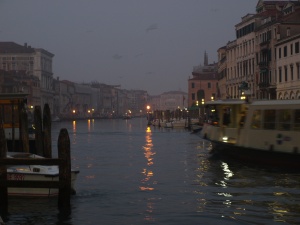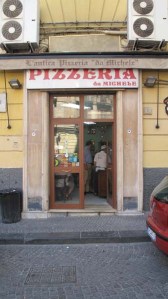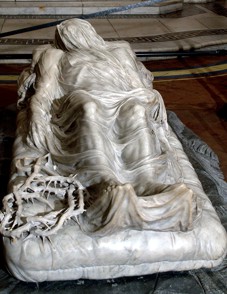Poveglia Island ~ The Island of Death a.k.a. The Island of NO Return!!
Have you every heard of Poveglia Island? Not many people have, yet it lies right the there in the beautiful Venice Lagoon. It’s impossible to find a water taxi, local venetian boat owner who will take curious tourists to the island. Multiple guide books describe the island as “abandoned and not visitable.” So how could it be that a stones throw away from some of the most pristine real estate in the entire world, Poveglia Island, remains uninhabited, with only a few old buildings rotting away? Because according to legend, the island was formed from the ashes of burned plague victims, criminals and mental patients who were exiled there is haunted with evil spirits.
A stroll through any of Venice’s streets will bring you to one of many Maschera shops. Inside you will find the most recognizable and spooky Venetian mask – Medico della Peste (The Plague Doctor) worn for protection by plague doctors, with its long curved beak shaped like a bird and glass openings for the eyes. Straps held the beak in front of the doctor’s nose had two small nose holes and was a type of respirators which contained aromatic items such as lavender and rose. The mask along with an ankle length black cloak, white gloves, long stick and wide brimmed leather hood indicated their profession. So one can only imagine, how many Medico della Peste were seen walking through the Republic of Venice in the 15th – 16th centuries, as the black plague spread rapidly throughout Europe.
Those who were thought to be infected with the plague were shipped against their will and placed in quarantine on the Island. It is thought that hundreds of thousands of people died and were burnt in mass graves, many which remain untouched even by archaeologists to this very day. In 1922, a building on Poveglia island was used as an asylum for the insane. A legend surrounding the asylum states that a doctor tortured and butchered many of the patients, then he himself went insane and jumped to his death from the bell tower. It’s said that it was not the fall which killed him – but a mysterious mist that rose from the ground and strangled the life out of the murderous medic.
A handful of people have dodged the police patrol that guards the island, and all have sworn never to return. They’ve said a feeling of the most intense evil and the screaming and moans that reverberate around the island are simply unbearable. One thrill-seeker, upon entering the deserted hospital, was told, leave immediately and do not return. Several well known ghost hunters, have made their way to Poveglia Island, all have confirmed and documented the overwhelming presence of evil and lingering spirits. They say that Venice’s dark and misty canals, embraced by heavenly palazzo’s – echoed with the haunting cries of those never to return to La Serenissima from Poveglia Island.
The Coliseum Rome
The Coliseum was where gladiator’s, fought to the finish for the entertainment of Emperors and the elite Romans. Slaves, prisoners and war victims met their death at the jaws of exotic creatures, some never seen before by the Romans. Countless numbers of tigers, cheetahs, lions, were killed. Some animal were driven to extinction due to Romans thirst for blood and gore. The endless rows of vaults below the Coliseum is where the gladiators awaited to fight, prisoners waited for their time to die in the most grisly of ways. Those who came to see the matches bet on the outcome and the more violent the better they liked it. With all that carnage and pure evil, it should come as no surprise, visitors and tour guides have reported many paranormal experiences. Visitors have experienced, cold spots, some have said they felt someone touch or push them, and heard someone whispering in their ears. Some have also claimed to hear sword clashing, sounds of crying, and noises of animals such as the roars of lions. Some have even seen ghostly figures sitting in the seats of the Coliseum. This ancient Coliseum, is a one of the most famous and visited sites in Rome. The dichotomy of those who were privileged enough to watch the show and those who took their last breaths in front of them is not lost on most.
Crypt of the Capuchin Monks in Rome
This church is made entirely out of the skeletons of its former friars. Not possible? Well, that’s exactly what you will find at the Crypt of the Capuchin Monks. Located right off the Via Veneto, the crypt is decorated with the bones and skulls of more than 4,000 monks, all arranged into interesting patterns, such as star-bursts and crucifixes.
The Girl With Blue Hair
The legend of Azzurrina has been known in the area near Rimini for many centuries.
In the 14th century there was Guendolina, a girl-albino with snow-white hair in the Montebello castle (Castello di Montebello). Her parents were worried about the popular superstitions according to which albino-people were somewhat demonic.
Thus, her father forbade the girl to leave the castle and her mother coloured Guendolina’s hair dark but it always ended up looking as blue as her eyes, so she was nicknamed Azzurrina (“Azzurro” translates to “blue” in Italian). On the summer solstice, while playing in the basement of the castle, blue haired Guendolina disappeared. Some said her father killed her but her body was never found.
Now, apparently, every five years on June 21, the day of the summer solstice, people hear a strange sound in the castle: the sound of a girl crying, shouting for help and calling “mamma”.
Capuchin Catacombs in Sicily
Imagine walking into a crumbling stone crypt and coming face to face with row upon row of carefully preserved mummies. This very sight greets thousands of tourists in Palermo, Sicily, each year.
Approximately 8,000 mummies are housed in niches along the walls of the Capuchin Catacombs.Hung from hooks by their necks and feet, they wear expensive-looking clothes and their heads hang as if in prayer. Some were then embalmed, while others were sealed in glass cases. This remained the method of mummification until the tombs were officially closed in 1871.
The Sicilians used a unique process of mummification.Bodies were hung on ceramic pipes in the catacombs, to dry out for up to eight months, before being washed with vinegar and exposed to the open air.
The last person to be interred there was a small girl, aged only two, called Rosalia Lombardo, in 1920.Her body survives almost entirely intact – from her dark blonde flowing hair to her delicate eyelashes. She reputedly died of pneumonia and was embalmed by a doctor called Alfredo Salafia – the only person in Capuchin capable of doing the embalming. Dr Salafia took the secrets of his remarkable embalming process to the grave, but Rosalia Lombardo continues to fascinate the many tourists who visit her.
The Ghost of Love
Bardi Castle (Castello di Bardi) near Parma is thought to be one of the most haunted castles in Italy. The legend goes that in the 14th century a young officer called Moroello fell in love with Soleste, a beauty young girl from a local noble family. The couple couldn’t display their love in public as Moroello was not of noble blood and Soleste’s family would never have given the couple permission to marry. (Sounds very Romeo and Juliet!)
When the young officer left for a battle, the fair Soleste awaited his return on the walls of the castle. Every single day,waiting on the arrival of Moroello to come back to her side. One day, after more than a month of waiting, Soleste saw a group of soldiers approaching the castle. They soldiers carried the enemy’s flags. Soleste, thinking that her lover had been killed, jumped off the high castle wall to her death.
However the men were Moroello’s soldiers were showing off the insignia of the army they had just defeated in triumph. When the brave Moroello found out what happened to the love of his life, he decided to join her and promptly threw himself off one of the castle’s towers.
It is said that this very day the ghost of Moroello wanders the castle grounds trying to find his beloved Soleste.
The Evil Eye – The Malocchian Curse
It is believed that there are two types of Malocchio, malevolent and involuntary. Most of the cases are believed to be the latter. The intentional type is called overlooking and is witchcraft meant to harm and cause misfortune. In the Middle Ages, people believed witches did this to bewitch judges into not convicting them and to curse people whom they were angry with.
The involuntary type is when a person may admire or be envious of another’s children or property. It could also result from gazing at another too long. Something has to be done to prevent or cure this. Usually, an older wise woman knows what must be done.
To test whether or not this is the case, put three drops of olive oil, one on top of the other in a bowl of water. If they stay together, it is not Malocchio. If they separate or become smeared it is.
To break the spell, insert the tip of a needle into the eye of another needle while chanting, “
“Occhi e contro e perticelli agli occhi, crepa la invida e schiattono gli occhi.” That means “Eyes against eyes and the holes of the eyes, envy cracks and eyes burst.” She then dropped the needles on top of three drops of olive oil in water and sprinkled three pinches of salt into the water. The strega (witch) would then jab scissors into the water through the oil three times and cut the air above the bowl three times and POOF! The spell was FINITO!
So is the spooky dark side of the boot enough to keep you away from Bella Italia?
.


